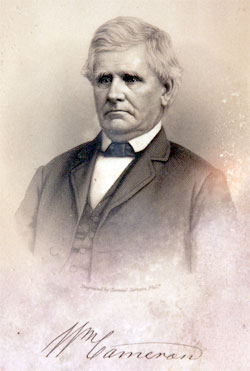
William Cameron: A Poor Boy Who Struck it Rich
William Cameron, son of Charles and Martha Pfoutz Cameron was born in Lancaster County on October 15, 1795.
William was the oldest of eight children of which the most illustrious was Simon, who served several terms in the U.S. Senate, was Secretary of War, 1861-1862 and severed as Ambassador to Russia, 1862-1865. Another brother, Colonel James Cameron was killed at the Battle of Bull Run.
Charles Cameron moved his family from Lancaster County to Sunbury in 1808, later Washingtonville, and in 1810 to Lewisburg. Here he operated a tailor shop until the time of his death in 1814. His wife, Martha died in 1830. Both are buried in the Lewisburg cemetery on the same plot with the William Cameron family.
William worked with his father at the tailor trade for several years. In 1814 he volunteered as a private in the “Northumberland Blues” Regiment under Colonel Weirick, and served till the end of the War of 1812. On January 5, 1820 he married Eleanor McLaughlin. Eight children were born to this union; Elizabeth, Mary, Martha Jane, Margaret, Mary Martha, Simon, and William Jr. and Jane. Four of the children died in infancy or early childhood, and only two outlived him. These were Mary, wife of John B. Packer of Sunbury and Jane, wife of Dr. Francis C. Harrison of Lewisburg.
William Cameron was appointed a Justice of the Peace by Governor Schulze on February 19,1827, and he held that office until the adoption of the Constitution of 1838 when justices were elected by popular vote. From 1839 to 1841 he was engaged in the wholesale dry goods business in Philadelphia. He also, in partnership with his brother, Simon did much contract work in canal and railroad construction.
In 1853 he established the Lewisburg Savings Institution which later became the Lewisburg National Bank. During its early years the bank was operated from the Cameron residence at Second and Market Streets (southwest corner). In the summer of 1887 the business was moved across the street (southeast corner) to the building now occupied by the Heim Insurance Agency. William Cameron served as president of the bank for two terms, 1853-1855 and 1857-1868. In 1927, the bank moved to its present location at Fourth and Market Streets.
William Cameron lived through many significant historical events, both nationally and locally. These included the War of 1812, the era of railroad and canal building, the Mexican War, the slavery issue and the Civil War, and the Panic of 1873. In spite of these setbacks the community continued to move forward. In 1855, Lewisburg became the county seat of Union County, which led the construction of the courthouse at Second and St. Louis Streets. The building cost $25,000 and the amount was raised by entirely by public subscription. William Cameron served as a member of the building committee. In 1869, the first railroad entered Lewisburg, and the following year the streets were first lighted by gas.
In 1874, when the country was still in the throes of the Panic of 1873, William Cameron made a gift of $10,000 to the Borough of Lewisburg for the purchase of a Silsby Steam Fire Engine together with hose and hose carriages. In his honor the fire company was named the William Cameron Engine Company.
At the time of his death on September 10, 1877, William Cameron was one of the wealthiest men in the community. His holding included more than a dozen farms and parcels of land with a total of roughly 2,000 acres, six houses, many lots, a large number of mortgages, U.S. Bonds, railroad bonds bank stock in three banks (Lewisburg, Sunbury, and Middleburg), bridge stock in both the Lewisburg and Milton bridges, and extensive coal lands. His fortune was variously estimated from seven hundred thousand dollars to two million dollars.